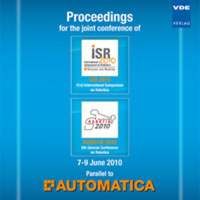Application of Pseudo-Elastic Wire for Hybrid Cutting Robotic Tool
Konferenz: ISR/ROBOTIK 2010 - ISR 2010 (41st International Symposium on Robotics) and ROBOTIK 2010 (6th German Conference on Robotics)
07.06.2010 - 09.06.2010 in Munich, Germany
Tagungsband: ISR/ROBOTIK 2010
Seiten: 8Sprache: EnglischTyp: PDF
Persönliche VDE-Mitglieder erhalten auf diesen Artikel 10% Rabatt
Autoren:
Masood, Jawad; Zoppi, Matteo; Molfino, Rezia (Univ. of Genoa, Dept. of Mech. and Machine Design, PMAR Robotics, Italy)
Inhalt:
The paper presents a development case of robotic machine for the dismantling of steel-concrete structures using diamond wire technology. The focus is on the application of the so called soft-wire with core made of superelastic alloy in place of the steel rope traditionally used. Remote-controlled machinery operating in risky areas must be the simplest possible for reliability and to shorten the development time as generally these machines are tailored to the task. In the case of dismantling of nuclear equipment there are two additional reasons to prefer simple designs: the need to decommission the cutting machinery together with the nuclear wastes and the limit to the use of electronics onboard due to radiation. With steel-cored cutting wires an active tensioner is needed to compensate for tension shocks occurring during cutting. This is the most complex component of the cutting system and it requires a control system with actuation and some electronics. A significant benefit comes from the removal of the active tensioner. The current direction is the use of soft wires in place of the ones with steel core. The steel rope is replaced by a core wire made of superelastic alloy. The tension of the wire is an independent cutting parameter. The selection of the core wire architecture and diameter, the point along the stress-strain curve where the wire superelastic alloy is in nominal conditions and the use of stress-strain plafond in the curve are critical. The paper discusses first the principles of cutting with soft wire. Then the design of the cutting system is addressed and the requirements of robotized cutting machinery is discusses. Different simulation schemes and approaches are proposed to model cutting forces and system dynamics.In a multibody model with the wire treated as a discontinuous flexible winded along a system of pulleys. The data from the multibody analysis is used in the Finite elements to characterize the static and dynamic response of Pseudo-elastic wire segment between the two diamond beads.


